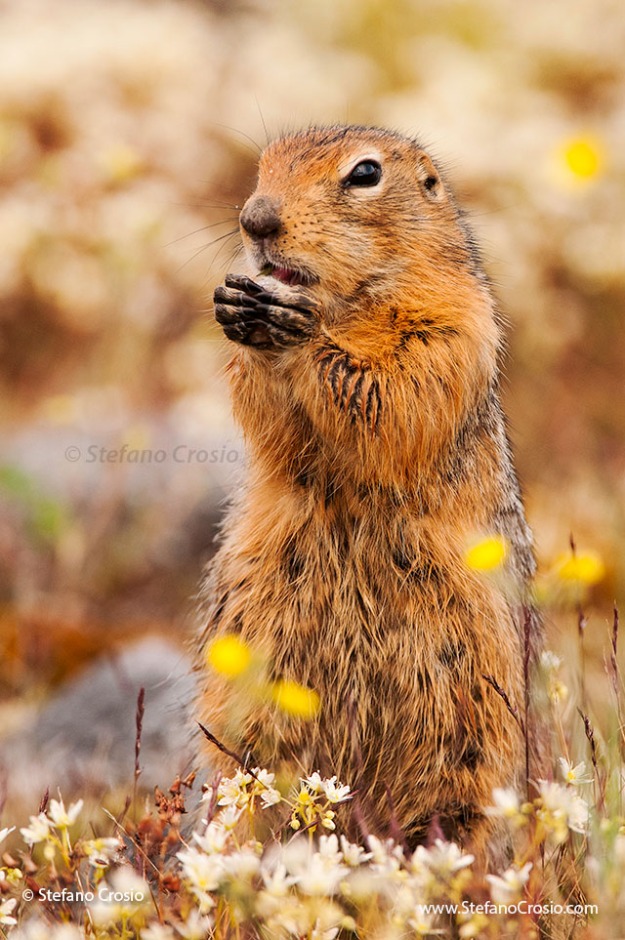Thought so. Quite honestly, neither had I – at least before I traveled to Canada’s arctic territory of Nunavut (I have published more photographs from that trip on this, this and this previous posts). Up there, beyond Inuit, caribou, wolves, arctic hare, the occasional polar bear and billions of mosquitoes and black flies you can find… sik-siks, which is the kind of cute sounding way Inuit call arctic ground squirrels because of the sound they make.
Arctic ground squirrels (Spermophilus parryii) are the largest and northernest among North American ground squirrels. They seek shelter from the frigid tundra temperatures by building a maze of burrows in areas where the permafrost does not prevent digging.
Throughout the long acrtic winters sik-siks hibernate for 7 to 8 months a year. Now get ready for a super cool fact: “Researchers at the University of Alaska at Fairbanks have shown that during hibernation, arctic ground squirrels adopt the lowest body temperature ever measured in a mammal. [Their] body temperature […] drops below freezing, a condition referred to as supercooling. At intervals of two to three weeks, still in a state of sleep, hibernating squirrels shiver and shake for 12 to 15 hours to create heat that warms them back to a normal body temperature of about 98 degrees Fahrenheit [(about 36.5 degrees Celsius)]. When the shivering and shaking stops, body temperature drops back to the minimal temperature” (quoted from the Denali page of the National Park Service’s Web site).
By the way, I have uploaded a new gallery to my Web site with a selection of my images of rodents and lagomorphs (i.e., rabbits and hares – no pikas, sorry): feel free to go take a look if you feel like it!
If you would like to see more images of mine, feel free to browse my Galleries.
As per my copyright notice, please respect my work and do not download, reproduce or use the image above without first seeking my consent. Thank you ![]()

their body temperature drops below freezing??? But they are not dead at the same time? That is amazing… I wish humans can do the same…
Isn’t it totally amazing? I had no idea any animal could do that! 🙂
Sik Sik – you are right have never heard of them but their hibernation is pretty impressive. He looks like he has it got something warm in his paws the way he is standing!
Thank you, Maria: I found their hibernation behavior to be nothing short of exceptional!
In the image, the ski-sik was munching on some newly bloomed flowers 🙂
Your animal pictures are so lovely you capture their expressions so brilliantly – each one I look at I can conjure up in my mind what I think they are thinking!
Thank you so much, Maria: it is a wonderful compliment that you paid me because that’s exactly what I am trying to achieve in my animal photographs. You really made my day! 🙂
Brilliant photo as usual Stefano!!
Thank you very much, Kimberly! 🙂
That is absolutely fascinating. I had no idea there were animals that could do that!! And, as always, a great shot, too!
Me neither! Isn’t it mind blowing? Nature can really be impressive in the way evolution made us all adapt to the environment we live in. I find fascinating.
Oh, and glad you liked the shot! 😉
Wonderful shot of an animal with an unusual but lovely name, until now I’d never heard of it. 🙂 Have a lovely weekend, Stefano. Thanks for this informative post, it’s a true pleasure to learn from you!
Dina
Thank you so much, Dina: it is actually a reciprocal learning journey, as I have learned so much from you and Klausbernd! 🙂
Big hugs,
Stefano
Goo golly, Stefano! If you’re not teaching me about wines, your giving me a lesson about wildlife. How fascinating is this animal’s hibernation? How incredible that it has evolved to survive in such an inhospitable climate for such a small creature! Thanks for sharing this creature with us — and your galleries.
You are way too kind, John: I am just sharing information that I find interesting, that’s all 🙂
And you are right on the money: I think evolution is such a powerful, magical force that in some circumstances like this just underpins life’s innate desire to thrive, even in the most extreme situations. Nothing short of amazing.
Thanks as always for your always thoughtful comments, John.
Wonderful photo. It’s rare that I meet someone who would understand my desire to visit Nunavut. But no, I hadn’t heard of a sik-sik.
If you miss the black flies, you don’t have to go that far north to enjoy the wee biting beasties. You can find them in swarms in June at our favorite vacation spot in the middle of nowhere, north of Ferme Nueve in Quebec. Which is why we always wait until late July to visit…
Did you travel on your own or with a group or guide?
Thank you, Tracy!
Oh man, I most certainly don’t miss those blood-thirsty beasts!!! What a nightmare!
I traveled with two photographer friends of mine. We hired a guide who was supposed to be great, but the whole experience was, to put it mildly, far from ideal. I would definitely not recommend that you use his services.
Having said that, Nunavut is an extreme land, that I found very interesting, thriving with life and definitely worth a trip.
Such a cute and great pic! Very charming! 🙂
Thank you, Sofia! 🙂